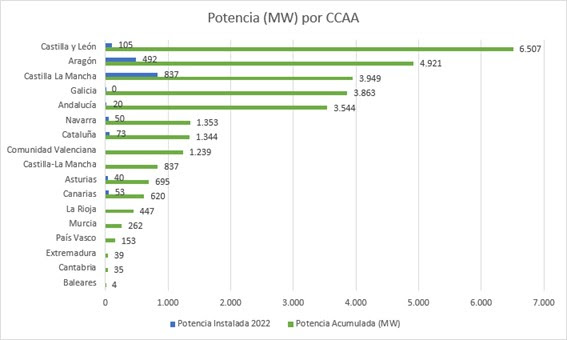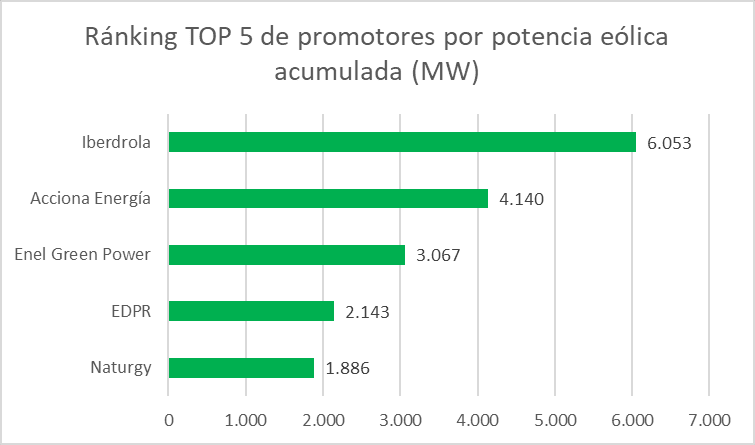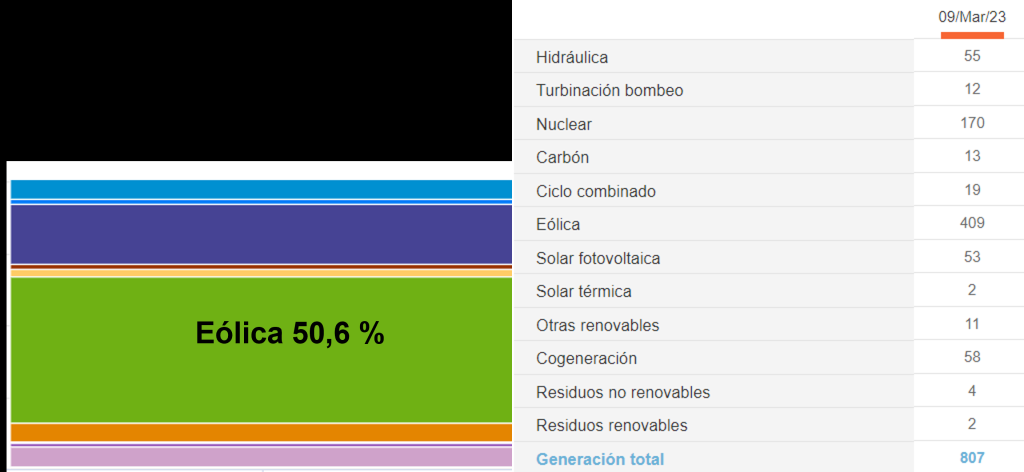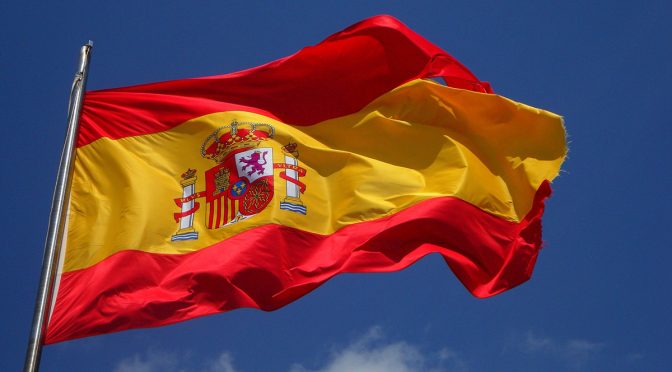Installed wind power in Spain reaches 29,813 MW with 1,670 new MW in 2022, doubling the figure installed the previous year, although at a rate below what is necessary to achieve the objectives of the National Integrated Energy and Climate Plan (PNIEC). The annual installation rate should incorporate 2,500 MW of wind energy per year.
• In total, in Spain there are 1,345 wind farms with 22,042 wind turbines. In 2022, 46 new wind farms have been commissioned with a total of 395 wind turbines.
• Existing wind farms generate 25% of all electricity in Spain. Yesterday, March 9, wind generated 50% of the electricity we consume. Today, March 10, it could reach 49%, which has made it easier for the daily spot price to be the lowest of the month with €42.71/MWh. Last year, thanks to wind power, electricity consumers saved 8,252 million euros.
• The 22,042 wind turbines in operation and their infrastructures occupy only 0.017% of the total Spanish area and are present in 13% of Spanish municipalities.

New power installed in 2022 in Spain
The exact figure of 1,670.10 MW of wind power installed in 2022 translates into 395 new wind turbines, reaching a generation record with more than 61,000 GWh, being a key technology in the energy mix due to its contribution to demand coverage and the first for installed potency. In terms of final energy, wind power is the main source of indigenous energy in Spain. In addition, last year wind power was a key element so that the price of electricity in Spain did not increase as much as in other countries, making Spanish citizens save more than 8,252 million euros on their electricity bills. The reducing effect of wind power in the accumulated of 2022 was €31.25/MWh. In other words, if we had not had wind energy, the average price of electricity in 2022 would have increased by 18% (from €167.61/MWh to €198.86/MWh).

Evolution of the annual and accumulated wind power installed in Spain. Source: PREPA
The new wind power installed in Spain accounts for 8% of the total in Europe. Spain is the sixth country in the ranking of countries with the largest wind power installed in Europe in 2022, behind Germany, Sweden, Finland, France and the United Kingdom.
Spain is the second European country with the most installed wind power (12% of the total percentage), behind Germany with more than 66 GW. The third is the United Kingdom (29 GW), followed by France (21 GW), Sweden (15 GW) and Turkey (12 GW). All of them add up to two thirds of the total installed capacity in Europe.
Currently, wind energy in Europe produces more than 17% of the electricity consumed on the continent and has a cumulative capacity of 255 GW of which 30 GW is from offshore wind.
Presence of wind power in Spain by Autonomous Communities
Wind energy is present in practically all the Autonomous Communities of Spain, except Madrid, Ceuta and Melilla. In 2022, the Autonomous Communities that have installed the most wind power are Castilla La Mancha with 837 MW, followed by Aragón with 492 MW and in third place Castilla y León with 105 MW.
The ranking of Autonomous Communities by installed wind power places Castilla y León as the leader with 6,507 MW, followed by Aragón with 4,921 MW and Castilla-La Mancha with 3,949 MW.
Wind power installed in 2022 in the Autonomous Communities and accumulated power. Source: PREPA
In total, in Spain there are 1,345 wind farms with 22,042 wind turbines installed in 13% of the municipalities. In 2022, 46 new wind farms have been commissioned with a total of 395 wind turbines. Existing wind farms generate 25% of all electricity in Spain and the 22,042 wind turbines and their infrastructures occupy only 0.017% of the total Spanish area.
To achieve the 2030 goal of the PNIEC of supplying 34% of electricity thanks to the wind, it is necessary to install 500 wind turbines per year (a total of 4,000), with which the total occupation of the territory by wind turbines and their infrastructures will represent 0.021%. of the total land area of the country.
Spain, leader in the manufacture of wind turbines
Spain has more than 250 manufacturing centers present in sixteen of the seventeen autonomous communities. In Spain we have 100% of the complete supply chain, we are leaders in the manufacture of wind turbines and we stand out as one of the countries with the largest export of machines. The manufacturing capacity in our country is 4,000 MW/year. In terms of employment, the sector has reached more than 32,000 jobs and is expected to double by 2030.
| Los fabricantes de aerogeneradores que lideran el ranking por potencia eólica total acumulada en España son Siemens Gamesa, Vestas, General Electric, Nordex Acciona Windpower y Enercon. En 2022, los cinco fabricantes que más han instalado eólica en nuestro país son Nordex Acciona Windpower, Siemens Gamesa, General Electric, Vestas y Enercon. Las empresas promotoras que lideran el ranking por potencia total acumulada en España son Iberdrola, Acciona Energía, Enel Green Power/Endesa, EDPR y Naturgy. En 2022, las empresas promotoras que más potencia eólica han instalado son Enel Green Power/Endesa, GECAMA, Elawan Energy, Eni Plenitude y Molinos del Ebro. |

| Potencia eólica instalada por empresas fabricantes en 2022 y potencia acumulada. Fuente: AEE |

| Potencia eólica acumulada por promotores. Fuente: AEE |
| Una previsión de incremento de 12 GW eólicos en los próximos 5 años El sector eólico español calcula que, si se obtiene la financiación necesaria, se instalen 7,2 GW nuevos hasta 2025 (de los 11,5 GW que actualmente tienen DIA positiva) y otros 5 GW adicionales hasta 2027 (de los 36 GW que están en tramitación y que deberían terminarla en los próximos dos años). En total 12,2 GW de nueva capacidad eólica hasta 2027, convirtiendo España en uno de los mayores mercados de Europa. Si se consigue este ritmo de avance en los próximos años, nos acercaríamos a la senda necesaria para cumplir con el objetivo del PNIEC actual de alcanzar 50,3 GW de potencia eólica instalada para 2030.Nuestra industria necesita sostenibilidad y confortabilidad en toda la cadena de valor para mantenerse y ser competitiva. La industria necesita tener visibilidad de mercado a más largo plazo, y no sólo de los 2 próximos años, a fin de realizar una planificación estratégica adecuada que conlleve una optimización de costes. El efecto de pasar de una sequía de proyectos a una acumulación masiva, motivada por el cumplimiento de unos hitos en la regulación, aunque pueda aportar un escenario teórico favorable a futuro, genera tensiones industriales y saturación en la cadena de suministro que suponen un gran reto para la cadena de suministro.Es clave avanzar a un ritmo constante y planificado en base a la demanda real de cada momento, y así llegar a 2030 con la aportación renovable que establezca el PNIEC, siempre maximizando los beneficios en los territorios y el respeto al medio ambiente. La tramitación administrativa es uno de los principales caballos de batalla y, por ello, todos los países debemos sumar fuerzas y priorizarla como asunto crítico para nuestra resiliencia energética, económica e industrial.Nuevo récord de la eólica con una generación superior al 50% en el balance diario La energía eólica ha generado un 50,6% en la península el 9 de marzo, llegando a superar la producción de 21.000 MWh en tramos horarios de la tarde, récord absoluto de generación eléctrica. A lo largo del día, la eólica generó en la península un total de 409 GWh, equivalente a más del 50% de la electricidad generada. A nivel nacional, la eólica ha producido 413 GWh en la fecha indicada. Si se cumple la previsión para hoy, 10 de marzo, también se podría alcanzar el 49,6% de la generación total gracias al viento, y una cobertura de la demanda peninsular diaria del 63% (con una exportación del 15% de la generación) con una generación total de 420 GWh. Gracias a esta aportación eólica, el precio diario del mercado spot de electricidad ha bajado a 42,17 €/MWh, que es el valor más bajo del mes. |

| La generación eólica peninsular el 9 de marzo de 2023 ha sido el 50,6%. Fuente: REE |
The wind turbine manufacturers that lead the ranking by total cumulative wind power in Spain are Siemens Gamesa, Vestas, General Electric, Nordex Acciona Windpower and Enercon. In 2022, the five manufacturers that have installed the most wind power in our country are Nordex Acciona Windpower, Siemens Gamesa, General Electric, Vestas and Enercon.
The developer companies that lead the ranking by total accumulated power in Spain are Iberdrola, Acciona Energía, Enel Green Power/Endesa, EDPR and Naturgy. In 2022, the developer companies that have installed the most wind power are Enel Green Power/Endesa, GECAMA, Elawan Energy, Eni Plenitude and Molinos del Ebro.
Wind power installed by manufacturing companies in 2022 and accumulated power. Source: PREPA

Wind power accumulated by developers. Source: PREPA
A forecast increase of 12 GW of wind power in the next 5 years
The Spanish wind sector calculates that, if the necessary financing is obtained, 7.2 new GW will be installed until 2025 (of the 11.5 GW that currently have a positive DIA) and an additional 5 GW until 2027 (of the 36 GW that are in process and should finish it in the next two years). In total 12.2 GW of new wind capacity until 2027, making Spain one of the largest markets in Europe. If this rate of progress is achieved in the coming years, we would be close to the necessary path to meet the objective of the current PNIEC of reaching 50.3 GW of installed wind power by 2030. Our industry needs sustainability and comfort throughout the supply chain. value to stay and be competitive.

The industry needs to have market visibility in the longer term, and not just for the next 2 years, in order to carry out adequate strategic planning that leads to cost optimization. The effect of going from a drought of projects to a massive accumulation, motivated by the fulfillment of some milestones in the regulation, although it may provide a favorable theoretical scenario for the future, generates industrial tensions and saturation in the supply chain that represent a great challenge. for the supply chain. It is essential to advance at a constant and planned pace based on the real demand at any given time, and thus reach 2030 with the renewable contribution established by the PNIEC, always maximizing the benefits in the territories and respect for the environment. Administrative processing is one of the main workhorses and, therefore, all countries must join forces and prioritize it as a critical issue for our energy, economic and industrial resilience. New record for wind power with a generation of more than 50% in the daily balance
Wind energy generated 50.6% on the peninsula on March 9, exceeding the production of 21,000 MWh in afternoon time slots, an absolute record for electricity generation. Throughout the day, wind power generated a total of 409 GWh on the peninsula, equivalent to more than 50% of the electricity generated. At the national level, wind power has produced 413 GWh on the indicated date. If the forecast for today, March 10, is fulfilled, 49.6% of the total generation could also be reached thanks to the wind, and a coverage of the daily peninsular demand of 63% (with an export of 15% of the generation ) with a total generation of 420 GWh. Thanks to this wind contribution, the daily price of the electricity spot market has dropped to €42.17/MWh, which is the lowest value of the month.
The peninsular wind generation on March 9, 2023 was 50.6%. Source: REE

